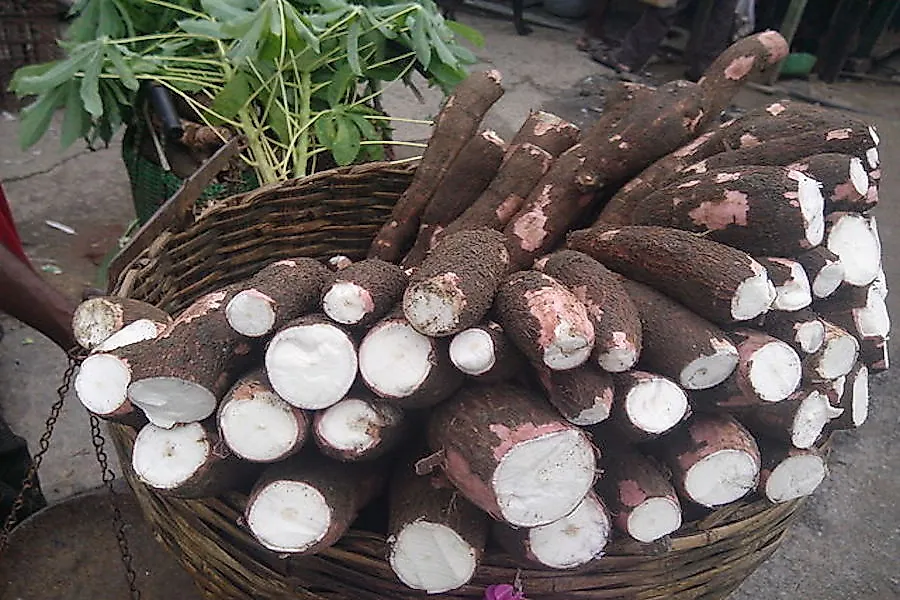Top Cassava Producing Countries In The World

"Manihot esculenta" or "cassava" is a woody shrub of the Euphorbiaceae family that is native to South America. The edible starchy tuberous root of cassava is consumed worldwide. It is presently grown as an annual crop in subtropical and tropical regions of the world.
Physical Description
Cassava has a long and tapered root with commercial cultivars being 5 to 10 cm in diameter at the top, and 15 to 30 cm in length. The flesh of the cassava is chalk-white to yellowish in color.
Uses Of Cassava
Roots of the plant are starch-rich with small amounts of vitamin C, phosphorus, and calcium. Proteins and other nutrients are present in negligible amounts. However, leaves of cassava are a rich protein source but deficient in certain amino acids.
Production Of Cassava
In 2014, 268 million tons of cassava was produced. The world’s largest producer of cassava is Nigeria with a production of 47,406,770 tons in 2013. With a production of 30,227,542 tons, Thailand follows next. Indonesia (23,936,920) and Brazil (21,484,218) rank third and fourth in the world in cassava production.
The Economic Importance Of Cassava
Cassava is an important food source in the tropics and provides the third-highest carbohydrate yield among the crop plants. Since the plant grows well in poor soils and low rainfall areas, it is a popular crop in the countries of sub-Saharan Africa. Cassava tolerates a wide variety of growth conditions including soils with pH ranging from acidic to alkaline, annual rainfalls from 50 mm to 5 m, elevation between sea-level and 6,600 feet, and even equatorial temperatures. The fact that it is a perennial plant makes it easy to harvest the crop when required and treat it as a food reserve during droughts and famines. Cassava thus serves as both a cash and a subsistence crop.
African nations are the most heavily dependent on root and tuber crops like cassava, yams, and sweet potatoes. In some countries of sub-Saharan Africa, cassava is even a staple or a sub-staple. In Ghana, 46% of the GDP of the country is contributed by trade in cassava. Nearly every farming family in the country grow cassava and it accounts for the daily caloric intake of at least 30% of the residents of the country.
In India, cassava is a staple food in the Kerala and Andhra Pradesh states of the country. It is also consumed as an important carbohydrate source in Assam. The cassava produced in Thailand and Vietnam find the largest export market in China. In China, the Guangxi province is responsible for about 60% of the country’s cassava production. Several types of alcoholic beverages are also made from cassava. Cassava is also an important part of many cuisines worldwide. Cassava also has certain toxic properties that must be treated before consumption.
Significant research is being done to evaluate the use of cassava as a source of biofuel. Cassava tubers are also used as an important animal feed. A number of laundry products use utilize cassava derivatives as laundry starch.
Top Cassava Producing Countries In The World
| Rank | Area | Production Value Of Cassava (in tons) |
|---|---|---|
| 1 | Nigeria | 47,406,770 |
| 2 | Thailand | 30,227,542 |
| 3 | Indonesia | 23,936,920 |
| 4 | Brazil | 21,484,218 |
| 5 | Angola | 16,411,674 |
| 6 | Ghana | 15,989,940 |
| 7 | Democratic Republic of the Congo | 14,611,911 |
| 8 | Viet Nam | 9,757,681 |
| 9 | Cambodia | 7,572,344 |
| 10 | India | 7,236,600 |
| 11 | Malawi | 4,813,699 |
| 12 | United Republic of Tanzania | 4,755,160 |
| 13 | Cameroon | 4,596,383 |
| 14 | China, mainland | 4,585,000 |
| 15 | Mozambique | 4,303,000 |
| 16 | Benin | 3,910,036 |
| 17 | Sierra Leone | 3,810,418 |
| 18 | Madagascar | 3,114,578 |
| 19 | Uganda | 2,979,000 |
| 20 | Rwanda | 2,948,121 |











